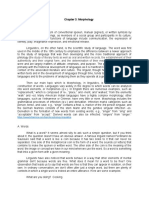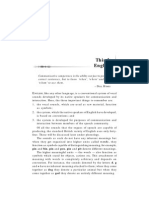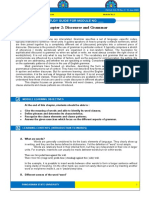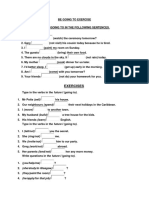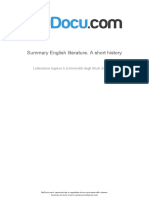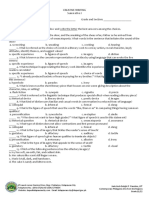1 Words and Word Classes: English Majors and Minors, Year II, Autumn 2009-2010
Uploaded by
Petronela Pavaluca1 Words and Word Classes: English Majors and Minors, Year II, Autumn 2009-2010
Uploaded by
Petronela PavalucaEnglish Majors and Minors, year II, autumn 2009-2010
Lecture 1
1 Words and word classes
In grammar, we first need to identify the types of grammatical units, such as
words and phrases, before describing the internal structure of these units, and how
they combine to form larger units. Grammatical units are meaningful elements which
combine with each other in a structural pattern. Essentially, grammar is the system
which organizes and controls these form - meaning relationships.
The types of grammatical units can be graded according to size of unit, as
shown below:
(discourse)
1. sentence: If I wash up all this stuff somebody else can dry it.
2. clauses: If I wash up all this stuff / somebody else can dry it.
3. phrases: if / I / wash up / all this stuff / somebody else / can dry it.
4. words: If / I / wash / up / all / this / stuff / somebody / else / can / dry / it.
5. morphemes: If / I / wash / up / all / this / stuff / some / body / else / can / dry /
it.
In the simplest cases, a unit consists of one or more elements on the level
below:
clause consists of one or more phrases.
phrase consists of one or more words.
word consists of one or more morphemes.
Morphemes are parts of words, i.e. stems, prefi!es, and suffi!es. "or
e!ample, un + friend + ly contains three morphemes: a prefi! un-, a stem friend and a
suffi! -ly. The part of grammar dealing with morphemes is morphology. The part of
grammar dealing with the other types of grammatical units shown above #i.e. words,
phrases, clauses, and sentences$ is %nown as synta.
Grammatical units can be combined to form longer written te!ts or spo%en
interaction, which is %nown as discourse. t the other e!treme, language can be
analyzed in terms of its phonemes #the individual sounds which ma%e up the language$
and graphemes #the written symbols we use to communicate in language$. These
are the smallest units of speech and writing, respectively.
Anca Cehan autumn 2009 1
In this course of lectures we focus mainly on the three central types of unit:
word, phrase, and clause. #&ote: in some grammars, the word 'sentence' is used in
a sense close to 'clause' in this course.$
In general, grammatical units are described in terms of four factors: their
structure, their syntactic role, their meaning, and the way they are used in discourse.
! "tructure
(nits can be described in terms of their internal structure: e.g. words in terms of
bases and affi!es, phrases in terms of heads and modifiers, and clauses in terms of
clause elements.
# $ole
(nits can be described in terms of their syntactic role. "or e!ample, a phrase can
have the syntactic role of ob)ect in a clause:
In November, Susie won those tickets.
In this e!ample, Susie is the sub)ect, in November is an adverbial.
% Meaning
(nits can be described in terms of meaning. "or e!ample, adverbs #a class of
words$ can e!press information about time, place, and manner.
& 'se (or discourse )unction*
(nits can be further described in terms of how they behave in discourse. This can
include their use in different registers, their fre*uency in those registers, and the factors
which influence their use in speech or in written te!ts. "or e!ample, pronouns li%e it
and they are often used to refer bac% to things mentioned earlier in the same
discourse:
Isn't indy comin!" #id she call you"
+uch pronouns are more common in speech than in written te!ts.
1+1 What are words,
,ords are generally considered to be the basic elements of language. They clearly
show up in writing, and they are the items defined in dictionaries. -et the definition of
'word' is not simple.
,ords are relatively fi!ed in their internal form, but they are independent in their
role in larger units. "or e!ample, insertions can usually be made between words but not
within words:
$here were two bi%es a!ainst the wall.
$here were two &lar!e new' bi%es &standin!' a!ainst the &side' wall.
Anca Cehan autumn 2009 2
&otice how, in the above e!ample, it is possible to insert words between other
words to form a longer sentence without losing clarity of meaning. .n the other hand,
we could not easily interrupt a word, by inserting another word or morpheme inside
it, as in (pedal-&new'-bins.
1+2 &i))erent senses o) the word 'word'
The notion of 'word' is comple!, and so it is useful to identify a number of
slightly different senses of 'word
)
:
-rthographic words. These are the words that we are familiar within
written language, where they are separated by spaces. "or e!ample, $hey wrote us a
letter contains five distinct orthographic words.
/rammatical words. word falls into one grammatical word class #or 'part
of speech'$ or another. Thus the orthographic word leaves can be either of two
grammatical words: a verb #the present tense -s form of leave' or a noun #the plural of
leaf'. This is the basic sense of 'word' for grammatical purposes.
Leemes: This is a set of grammatical words which share the same
basic meaning, similar forms, and the same word class. "or e!ample, leave, leaves, left,
and leavin! are all members of the verb le!eme leave. This is the meaning of 'word' that is
employed in dictionaries.
Each occurrence of a word in a written or spo%en te!t is a separate to0en. "or
e!ample, in the following line of conversation there are ten separate word to%ens:
$he birds and the deer and who %nows what else.
In contrast to word to%ens, word types are the different vocabulary items that
occur in a te!t #such as you would loo% up in a wordlist$. Thus, in the sentence above,
there are only eight word types &the, birds, and, deer, who, %nows, what, and else',
since and and the occur twice. &otice the to%en/ type distinction applies e*ually to
orthographic words, grammatical words, and le!emes.
1+1 2hree major )amilies o) words
,ords can be grouped into three families, according to their main function and
their grammatical behavior: leical words, )unction words, and inserts+
! Leical words
0e!ical words are the main carriers of information in a te!t or speech
act.
Anca Cehan autumn 2009 3
They can be subdivided into the following word classes #or parts o)
speech*. nouns, le!ical verbs, ad)ectives, and adverbs.
.f all the word families, le!ical words are the most numerous, and
their number is growing all the time. In other words, they are members of open
classes.
They often have a comple! internal structure and can be composed of
several parts: e.g. unfriendliness * un + friend 1 li 1 ness.
0e!ical words can be heads of phrases: e.g. the noun completion is the
head #or main word$ of the noun phrase 2the completion of the tas%3.
They are generally the words that are stressed most in speech.
They are generally the words that remain if a sentence is compressed
in a newspaper headline: e.g. +lderly care crisis warnin!.
# 3unction words
"unction words can be categorized in terms of word classes such as
prepositions, coordinators, au!iliary verbs, and pronouns.
They usually indicate meaning relationships and help us to interpret
units containing le!ical words, by showing how the units are related to each other.
"unction words belong to closed classes, which have a very limited and
fi!ed membership. "or e!ample, English has only four coordinators: and, or, but and
#rarely$ nor.
Individual function words tend to occur fre*uently, and in almost any type
of te!t.
% Inserts
Inserts are found mainly in spo%en language.
Inserts do not form an integral part of a syntactic structure, but tend to
be inserted freely in a te!t.
They are often mar%ed off by a brea% in intonation in speech, or
by a punctuation mar% in writing: e.g. Well, we made it.
They generally carry emotional and discoursal meanings, such as oh, ah,
wow, used to e!press a spea%er's emotional response to a situation, or yeah, no, o%ay,
used to signal a response to what has )ust been said.
Inserts are generally simple in form, though they often have an
atypical pronunciation #e.g. hm, uh-huh, u!h, yeah$. E!amples are: Hm hm, very
!ood, Yeah, I will. Be, !heers man.
Anca Cehan autumn 2009 4
Inserts are peripheral to grammar.
1+4 %losed classes and open classes
! closed class contains a limited number of members, and new members cannot
be easily added. "or e!ample, it is not easy to create a new coordinator or a new
pronoun, as those word classes have a fairly fi!ed set of members.
The membership of open classes is indefinitely large, and can be readily e!tended
by users of the language. 0e!ical classes such as nouns and ad)ectival are open
classes. "or e!ample, we can easily form new nouns with the suffi! ,ee, ad)ectives with
-ish, verbs with -i-e, and adverbs with -wise:
!ossipee, franchisee, internee, retiree
birdish, broadish, co.uettish, heathenish
bureaucrati-e, mytholo!i-e, periodi-e, solubili-e
crabwise, fanwise, fro!wise, starwise.
In practice, the difference between open classes and closed classes is not
always clear-cut. "or e!ample, new prepositions develop out of other word classes
#e.g. re!ardin!$, and se*uences of orthographic words can gradually become fi!ed as
a single preposition #e.g. on account of$. s a result, 'closed classes' are not
completely closed, but they are e!tended only slowly, over centuries. In contrast, new
nouns, verbs, ad)ectives, and adverbs - the open classes - are always being created.
1+5 Multi-word units, collocations, and leical 6undles
! multi-word unit is a se*uence of orthographic words which functions
li%e single grammatical unit: e.g. the preposition on top of or the adverb of course.
n idiom is a multi-word unit with a meaning that cannot be
predicted from the meanings of its constituent words#e.g. fall in love or ma%e up
&one' s' mind$.
4owever, the boundary between idioms and freely chosen combinations not
always clear.
! collocation is the relationship between two or more independent
words which commonly appear together #or co-occur$. The ad)ectives broad and
wide, for e!ample, are similar in meaning, but occur in very different
collocations:
broad accent, broad a!reement, broad dayli!ht, broad !rin, broad shoulders,
etc.5
wide appeal, wide area, wide e/perience, wide interests, wide mar!in, etc.
Anca Cehan autumn 2009 5
The term leical 6undle, is used for a se*uence of words which co-occur
very fre*uently, especially when the se*uence consists of more than two words: e.g., I
don't thin% ..., 0ould you mind ... etc.
2+ Leical word classes
Leical words
s already noted, there are four main classes of le!ical words: nouns, leical
7er6s, adjecti7es, and ad7er6s+ To decide what class a word belongs to, it is useful to
apply tests of three %inds:
Morphological. what forms does a word consist of #stems and affi!es$6
"yntactic. what syntactic roles does a word play in phrases or other
higher units6
"emantic. what type#s$ of meaning does a word convey6
2+1 8ouns
,ords such as boo%, !irl, !old, information are common nouns+ ,ords such
Sarah, 1slo, and 2icrosoft #names$ are proper nouns+ &ouns have the following
characteristics:
! Morphological characteristics
&ouns have in)lectional su))ies )or plural num6er, and for geniti7e case:
a boo% 3 two "ooks# $arah's boo%. 7any nouns, however, are uncounta6le, and
cannot have a plural form #e.g. !old, information$.
&ouns *uite often contain more than one morpheme:
compound nouns: bomb + shell, brid!e + head, clothes + line
nouns with derivational suffi!es: sin!+er, bri!ht + ness, friend + ship
# "yntactic characteristics
&ouns can occur as the head o) a noun phrase. 4a new "ook about the cold war5,
4the u!liest person you've ever seen5. s these e!amples show, common nouns such as
boo% and person can be modified by many %inds of words both before and after them.
8roper nouns li%e Sarah, on the other hand, rarely have any modifiers.
% "emantic characteristics
&ouns commonly refer to concrete, physical entities #people, ob)ects,
substances$: e.g. boo%, friend, iron. They can also denote abstract entities, such as
*ualities and states: e.g. freedom, wish, friendship.
Anca Cehan autumn 2009 6
2+2 Leical 7er6s
,ords such as admit, build, choose, write are leical 7er6s+ They are distinct from
auiliary 7er6s li%e can and will, which we treat as function words. The primary 7er6s be,
have, and do #the most common verbs in English$ occur as both le!ical verbs and
au!iliaries. 0e!ical verbs are identified as follows:
! Morphological characteristics
0e!ical verbs have different forms signaling tense #present and past$, aspect
#perfect, progressive$, and 7oice #active and passive$. &ote the five forms of the verb
le!eme write in these e!amples:
eample )orm
$hey write about their family. base
6e writes pa!e after pa!e about tiny details. third person present #-s
form$
$hey wrote about 7enus bein! a 8un!le paradise. past tense
6e has written to an old 8ournalist friend. ed-participle #or past
participle$
/ wonder if you are writin% any more son!s" in!-participle #or present
participle$
9erb le!emes *uite often have a comple! form with more than one
morpheme. The following are e!amples of multi-word verbs and derived verbs: brin! up&
rely on& loo% 'orward to& hyphenate, itemi(e, soften.
# "yntactic characteristics
0e!ical verbs most fre*uently occur on their own, as a single-word verb phrase
acting as the central part of the clause:
6e 4writes5 pa!e after pa!e about tiny details.
They also occur in the final or main 7er6 position o) 7er6 phrases. 4has written5 a
letter5 4will be writin%5 tomorrow.
% "emantic characteristics
0e!ical verbs denote actions, processes, and states of affairs that happen or e!ist
in time. They also define the role of human and non-human participants in actions,
processes, or states:
49ou5 4ate5 4hinese food5.
In this e!ample, ate e!presses the action performed by you on the hinese
food.
Anca Cehan autumn 2009 7
2+1 !djecti7es
,ords such as dar%, heavy, ea!er, and !uilty are ad)ectives. d)ectives are
identified as follows:
! Morphological characteristics
7any ad)ectives can ta%e the inflectional suffi!es -er #comparative$ and -est
#superlative$: dar% 3 dar%er 3 dar%est. d)ectives can be comple! in morphology:
derived ad)ectives #with suffi!es in bold$: accepta"le, for!et'ul, influential
compound ad)ectives: colour-blind, home-made, ice-cold.
# "yntactic characteristics
d)ectives can occur as the head of an adjecti7e phrase. 4very dark5, 4ea%er to
help5, 4%uilt of a serious crime5. d)ectives and ad)ective phrases are most commonly
used as modi)iers preceding the head of a noun phrase, or as predicati7es following
the verb in clauses:
modifier: $omorrow could be 4a sunn day5.
predicative: It's nice and warm in here. It)s sunn.
% "emantic characteristics
d)ectives describe the *ualities of people, things, and abstractions: a heavy bo/,
he is %uilt& the situation is serious+ 7any ad)ectives are grada6le+ That is, they can be
compared and modified for the degree or level of the *uality: heavier, very heavy,
e/tremely serious.
2+4 !d7er6s
,ords such as now, there, usually, and finally are adverbs. dverbs are a varied
word class, with the following characteristics:
! Morphological characteristics
7any adverbs are formed from ad)ectives by adding the suffi! -ly: clearly, ea!erly.
.thers have no such ending: however, 8ust. few adverbs allow comparative and superlative
forms li%e those for ad)ectives: soon3 sooner 3 soonest: fast3 faster 3 fastest.
# "yntactic characteristics
dverbs occur as head o) ad7er6 phrases. 4very noisil5, 4more slowl than I had
e/pected5. dverbs, with or without their own modifiers, are often used as modi)iers
of an ad)ective or another adverb: reall old, )er soon. .therwise, they can act as
ad7er6ials in the clause: I)ll see you a%ain soon+
Anca Cehan autumn 2009 8
% "emantic characteristics
s modifiers, adverbs most often e!press the degree of a following ad)ective or
adverb: totall wron!, ri%ht now. s elements of clauses #adverbials$, adverbs and
adverb phrases have a wide range of meanings:
: They can modify an action, process, or state, by e!pressing such notions
as time, place, and manner:
So I learned ;erman .uite *uickl.
She was here earlier today+
: They can convey the spea%er's or writer's attitude towards the information in
the rest of the clause:
$urel that child's not mine"
: They can e!press a connection with what was said earlier:
It must be beautiful, thou%h+
2+5 %omparing leical word classes in use
There are interesting similarities and contrasts in the use of the le!ical word classes
across the registers. ;egisters can be described in terms of their style by comparing their
use of the le!ical classes.
&oun
s and verbs are clearly the most common types of word overall.
<onversation has a high density of verbs, unli%e informative writing such as
news and academic prose, which has a high density of nouns.
d)ectives are lin%ed to nouns, because they most fre*uently modify nouns.
+o informative writing, which has the highest density of nouns, also has the highest
density of ad)ectives.
: dverbs are lin%ed to verbs. They typically describe circumstances
relating to actions, processes, and states that are denoted by verbs. +o conversation
and fiction writing, which have the highest density of verbs, also have the highest density
of adverbs.
2+9 #orderline cases in classi)ying words
The categories people operate with in the real world are not clear-cut. The
category of 'furniture=, for e!ample, includes clear cases, li%e tables and chairs, but also
less clear or borderline cases, such as television sets, coo%ers, and electric heaters.
The same is true of word classes in grammar. "or e!ample, nouns can be more
or less 'nouny'. typical noun #e.g. boy, car$ has singular, plural, and genitive forms
Anca Cehan autumn 2009 9
#e.g. boy, boys, boy's$. It can be preceded by a or the, and it refers to a class of people,
things, or other entities. -et in the class of nouns we find many words which have only
some of these 'nouny' features: e.g. research, which has no plural or genitive, cannot be
preceded by a, and refers to something abstract and intangible.
s some words may be more 'borderline' than others within a word class, it is
not surprising that the boundaries between two word classes may also be unclear.
The words ending with -in! are an e!ample of borderline cases in le!ical word
classes. lmost all of these words have a verb base, so it is easy to assume that alll
words ending in -in! are verbs. In fact, these words can belong to any of three different
classes: verb #sometimes called the in!-participle$, noun, or ad)ective #sometimes called
participial ad)ective$. &ormally the following tests can be applied to determine the word
class:
9erbs ending in -in! can act as the main verb of a verb phrase, and
may be followed by a noun or an ad)ective: e.g. is eatin% lunch : "ecomin% misty
overni!ht.
&ouns ending in -in! can sometimes have a plural form #e.g. paintin!s$,
and can usually be a head noun after a, the, or some other determiner: e.g. 2the
"annin% of some chemicals3, 2her dancin%3
d)ectives ending in -in! can appear before a noun, and can also occur
after verbs such as be and become: e.g. the tra)ellin% public5 it was &very' con'usin%.
They are very often gradable, and can be preceded by degree adverbs such as very,
so, and too: )er for!ivin!, so interestin!, too borin!.
>ut these criteria cannot always be clearly applied. Typical borderline case
include the following:
! 8ouns and 7er6s
The biggest problem here is the so-called na%ed in!-form occurring after a verb,
as in:
$he matter needed chec%in!.
In this e!ample the final word chec%in! could be a verb. If one added an adverb, it
would be a verb:
$he matter needed chec%in! carefully.
In other similar cases, this form could be functioning as a noun. If it were
preceded by a modifying ad)ective, it would clearly be a noun:
$he matter needed careful chec%in!.
Anca Cehan autumn 2009 10
+ince neither of these clues is present in the original e!ample, the word class
of chec%in! is left unclear.
# 8ouns and adjecti7es
The biggest problem here is where the in!-form modifies a following noun.
<ompare:
noun : noun adjecti7e : noun
li)in% standards li)in% creatures, dancin! classes, the dancin%
children
workin% conditions a workin% mother
>oth nouns and ad)ectives can modify a noun, so the only way to tell the
difference here is to apply a 'paraphrase test': i.e. to try to e!press the same idea in
different ways.
If a paraphrase can be found where the in!-form clearly has a noun-li%e
character, the construction consists of noun 1 noun. "or e!ample, if a
paraphrase which uses a prepositional phrase is appropriate, the construction must
consist of an in!-noun 1 noun: livin! standards ? standards of living5 dancin! classes ?
classes for dancing. In contrast, a paraphrase with a relative clause #using that, which,
or who$ shows that the construction consists of in!-ad)ective 1 noun: livin! creatures ?
creatures which are #still$ living5 dancin! children ? children who are dancing.
% ;er6s and adjecti7es
>orderline cases between these categories occur where the in!-form follows the
verb be without other modifiers. <onsider, for e!ample:
It was embarrassin!.
If the in!-word can ta%e an ob)ect #i.e. a following noun phrase$, then it is a verb:
It was embarrassin! &me'.
In contrast, if the in!-word is gradable and can be modified by very, it is an
ad)ective:
It was &very' embarrassin!.
In some cases #li%e this one with embarrassin!$, both tests apply, and there is no
single correct analysis. >ut the second analysis #ad)ective$ is more li%ely.
,ord classes, li%e virtually all grammatical categories, have uncertain
boundaries5 but this does not undermine their value as categories. ;ather,
grammar needs fle!ibility in its categories to enable people to communicate fle!ibly.
In the large ma)ority of actual instances, however, there is little ambiguity.
Anca Cehan autumn 2009 11
#i6liography.
>iber @., <onrad +., 0eech G. #ABBA$ <on!man Student ;rammar of Spo%en and 0ritten +n!lish,
0ongman
@owning #ABBC$ +n!lish ;rammar. = >niversity ourse, ;outledge
Greenbaum +., Duir% ;. #EFFB$ = Student)s ;rammar of the +n!lish <an!ua!e, 0ongman
4uddleston ;., 8ullum G., et al. #ABBA$ The ambrid!e ;rammar of the +n!lish <an!ua!e, <(8,
0eech G. #EFGF$ =n = , ? of +n!lish ;rammar and >sa!e, &elson,
Duir%, ;., Greenbaum +., 0eech G., +vartvi% H. #EFIA$ = ;rammar of ontemporary +n!lish,
0ongman
<elce-7urcia 7., 0arsen-"reeman @. #EFFF$ $he ;rammar @oo%, 4einle and 4einle
9ereJ G., <ehan ., ndriescu I. #EFFG$ = #ictionary of +n!lish ;rammar, 8olirom
Anca Cehan autumn 2009 12
You might also like
- Grammar I Lessons by Prof. Graciela Palacio (2012, Revised 2015) PDF100% (2)Grammar I Lessons by Prof. Graciela Palacio (2012, Revised 2015) PDF212 pages
- Lingua Inglesa Aspectos MorfossintaticosNo ratings yetLingua Inglesa Aspectos Morfossintaticos105 pages
- Comparing Two Stories: "Appointment With Love" and "The Chaser"No ratings yetComparing Two Stories: "Appointment With Love" and "The Chaser"2 pages
- Francis Scott Key Fitzgerald Biography EssayNo ratings yetFrancis Scott Key Fitzgerald Biography Essay3 pages
- 1 Words and Word Classes: English Majors and Minors, Year II, Autumn 2009-2010No ratings yet1 Words and Word Classes: English Majors and Minors, Year II, Autumn 2009-201012 pages
- Word, Word-Form, Lexeme: 21 October 2011No ratings yetWord, Word-Form, Lexeme: 21 October 201122 pages
- Grammatical Elements - Explanation and Summary ChartNo ratings yetGrammatical Elements - Explanation and Summary Chart4 pages
- MAX ENGLISH VOCABULARY COURSEWORK SUBMITTEDNo ratings yetMAX ENGLISH VOCABULARY COURSEWORK SUBMITTED24 pages
- L15_2 the Grammar of English_part 1_audio_098149c8655a373ea89d09573abd4641No ratings yetL15_2 the Grammar of English_part 1_audio_098149c8655a373ea89d09573abd464115 pages
- Lectures 7, 8 - Word Classes + ExercisesNo ratings yetLectures 7, 8 - Word Classes + Exercises28 pages
- Lectures 7 8 Word Classes Exercises PDFNo ratings yetLectures 7 8 Word Classes Exercises PDF28 pages
- KELOMPOK 1 MEETING ll WORD,SENTENCE,AND DICTIONARIESNo ratings yetKELOMPOK 1 MEETING ll WORD,SENTENCE,AND DICTIONARIES17 pages
- Component of Language: Submitted To Fulfill Psycholinguistics' TaskNo ratings yetComponent of Language: Submitted To Fulfill Psycholinguistics' Task7 pages
- Theoretical Grammar of English: Compiled by T. Ilyushchenya T.a.ilyushhenya@No ratings yetTheoretical Grammar of English: Compiled by T. Ilyushchenya T.a.ilyushhenya@34 pages
- Chapter 2: Discourse and Grammar: Study Guide For Module No.No ratings yetChapter 2: Discourse and Grammar: Study Guide For Module No.5 pages
- A Word Is A Minimal Free Form of A Language That Has A Given Sound, Meaning and Syntactic FunctionNo ratings yetA Word Is A Minimal Free Form of A Language That Has A Given Sound, Meaning and Syntactic Function2 pages
- I. O. Macari, Morpho-Syntax, Lecture 8 5. Word ClassesNo ratings yetI. O. Macari, Morpho-Syntax, Lecture 8 5. Word Classes8 pages
- The Paper Bag Princess - 240514 - 220409No ratings yetThe Paper Bag Princess - 240514 - 2204094 pages
- Writing Rubric - Includes Transitions and HookNo ratings yetWriting Rubric - Includes Transitions and Hook1 page
- Cohesive Devices List of Items For Writing A CompositionNo ratings yetCohesive Devices List of Items For Writing A Composition5 pages
- Exercise Conditional Sentences (Auxiliary Verbs) PembahasanNo ratings yetExercise Conditional Sentences (Auxiliary Verbs) Pembahasan1 page
- Summary English Literature. A Short History Summary English Literature. A Short History100% (1)Summary English Literature. A Short History Summary English Literature. A Short History56 pages
- 9 Storytelling Activities For The Story EngineNo ratings yet9 Storytelling Activities For The Story Engine1 page
- New Sincerity in David Foster Wallace S OctetNo ratings yetNew Sincerity in David Foster Wallace S Octet17 pages
- Mobile Suit Gundam SEED Episode DescriptionNo ratings yetMobile Suit Gundam SEED Episode Description8 pages
- Media-Based Arts and Design in The PhilippinesNo ratings yetMedia-Based Arts and Design in The Philippines29 pages
- Grammar I Lessons by Prof. Graciela Palacio (2012, Revised 2015) PDFGrammar I Lessons by Prof. Graciela Palacio (2012, Revised 2015) PDF
- Comparing Two Stories: "Appointment With Love" and "The Chaser"Comparing Two Stories: "Appointment With Love" and "The Chaser"
- 1 Words and Word Classes: English Majors and Minors, Year II, Autumn 2009-20101 Words and Word Classes: English Majors and Minors, Year II, Autumn 2009-2010
- Grammatical Elements - Explanation and Summary ChartGrammatical Elements - Explanation and Summary Chart
- L15_2 the Grammar of English_part 1_audio_098149c8655a373ea89d09573abd4641L15_2 the Grammar of English_part 1_audio_098149c8655a373ea89d09573abd4641
- KELOMPOK 1 MEETING ll WORD,SENTENCE,AND DICTIONARIESKELOMPOK 1 MEETING ll WORD,SENTENCE,AND DICTIONARIES
- Component of Language: Submitted To Fulfill Psycholinguistics' TaskComponent of Language: Submitted To Fulfill Psycholinguistics' Task
- Theoretical Grammar of English: Compiled by T. Ilyushchenya T.a.ilyushhenya@Theoretical Grammar of English: Compiled by T. Ilyushchenya T.a.ilyushhenya@
- Chapter 2: Discourse and Grammar: Study Guide For Module No.Chapter 2: Discourse and Grammar: Study Guide For Module No.
- A Word Is A Minimal Free Form of A Language That Has A Given Sound, Meaning and Syntactic FunctionA Word Is A Minimal Free Form of A Language That Has A Given Sound, Meaning and Syntactic Function
- I. O. Macari, Morpho-Syntax, Lecture 8 5. Word ClassesI. O. Macari, Morpho-Syntax, Lecture 8 5. Word Classes
- Chinese-English/English-Chinese (Mandarin) Practical DictionaryFrom EverandChinese-English/English-Chinese (Mandarin) Practical Dictionary
- Cohesive Devices List of Items For Writing A CompositionCohesive Devices List of Items For Writing A Composition
- Exercise Conditional Sentences (Auxiliary Verbs) PembahasanExercise Conditional Sentences (Auxiliary Verbs) Pembahasan
- Summary English Literature. A Short History Summary English Literature. A Short HistorySummary English Literature. A Short History Summary English Literature. A Short History




















